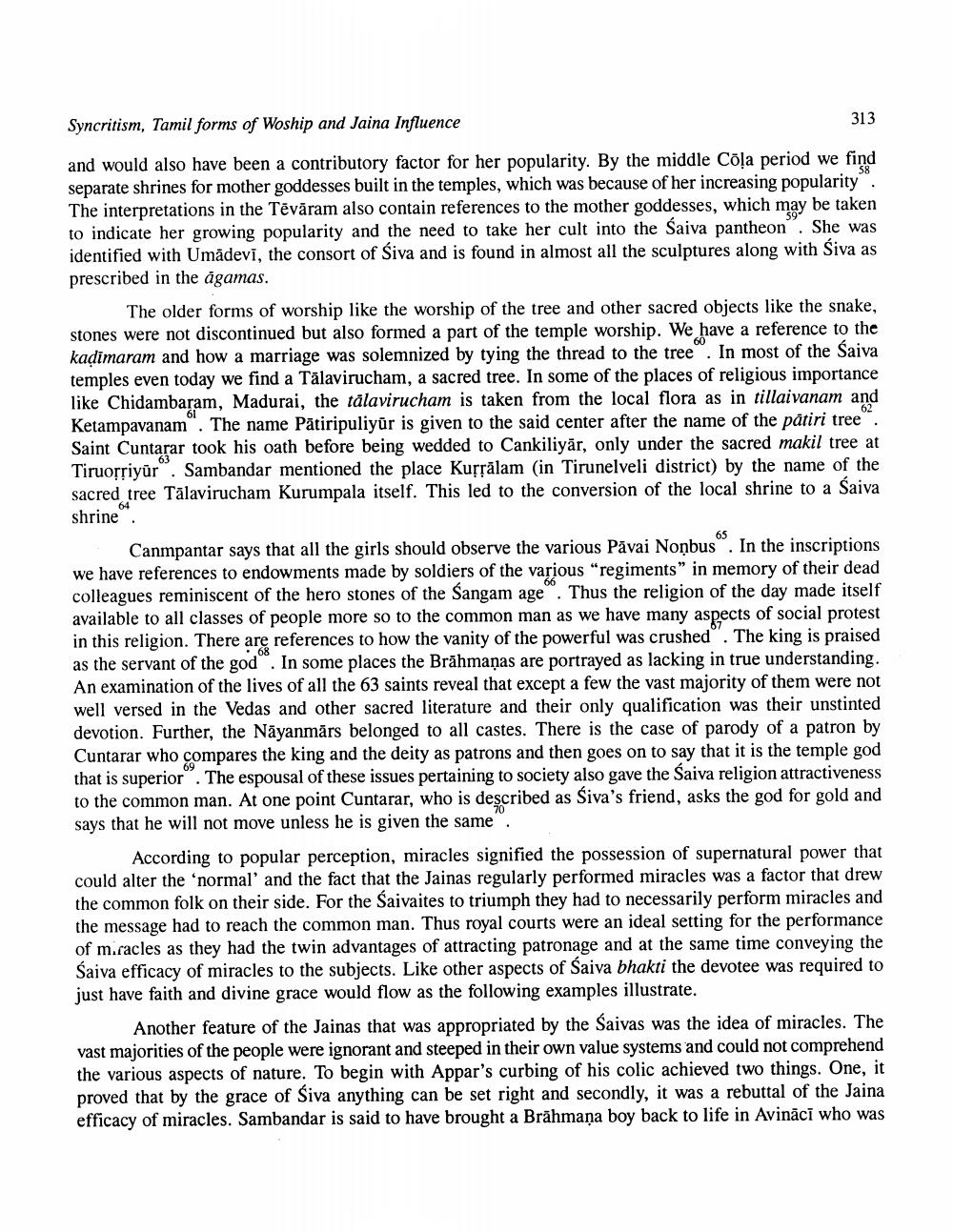________________
313
Syncritism, Tamil forms of Woship and Jaina Influence
58
and would also have been a contributory factor for her popularity. By the middle Cola period we find separate shrines for mother goddesses built in the temples, which was because of her increasing popularity". The interpretations in the Tēvāram also contain references to the mother goddesses, which may be taken to indicate her growing popularity and the need to take her cult into the Saiva pantheon". She was identified with Umadevi, the consort of Śiva and is found in almost all the sculptures along with Śiva as prescribed in the agamas.
60
The older forms of worship like the worship of the tree and other sacred objects like the snake, stones were not discontinued but also formed a part of the temple worship. We have a reference to the kaḍīmaram and how a marriage was solemnized by tying the thread to the tree. In most of the Saiva temples even today we find a Talavirucham, a sacred tree. In some of the places of religious importance. like Chidambaram, Madurai, the talavirucham is taken from the local flora as in tillaivanam and Ketampavanam. The name Pătiripuliyur is given to the said center after the name of the patiri tree. Saint Cuntarar took his oath before being wedded to Cankiliyar, only under the sacred makil tree at Tiruorriyar Sambandar mentioned the place Kurrālam (in Tirunelveli district) by the name of the sacred tree Tālavirucham Kurumpala itself. This led to the conversion of the local shrine to a Śaiva
62
64
shrine.
Canmpantar says that all the girls should observe the various Pavai Nonbus. In the inscriptions we have references to endowments made by soldiers of the various "regiments" in memory of their dead colleagues reminiscent of the hero stones of the Sangam age. Thus the religion of the day made itself available to all classes of people more so to the common man as we have many aspects of social protest in this religion. There are references to how the vanity of the powerful was crushed". The king is praised as the servant of the god. In some places the Brahmanas are portrayed as lacking in true understanding. An examination of the lives of all the 63 saints reveal that except a few the vast majority of them were not well versed in the Vedas and other sacred literature and their only qualification was their unstinted devotion. Further, the Nayanmars belonged to all castes. There is the case of parody of a patron by Cuntarar who compares the king and the deity as patrons and then goes on to say that it is the temple god that is superior. The espousal of these issues pertaining to society also gave the Saiva religion attractiveness to the common man. At one point Cuntarar, who is described as Siva's friend, asks the god for gold and says that he will not move unless he is given the same.
According to popular perception, miracles signified the possession of supernatural power that could alter the 'normal' and the fact that the Jainas regularly performed miracles was a factor that drew the common folk on their side. For the Saivaites to triumph they had to necessarily perform miracles and the message had to reach the common man. Thus royal courts were an ideal setting for the performance of miracles as they had the twin advantages of attracting patronage and at the same time conveying the Saiva efficacy of miracles to the subjects. Like other aspects of Saiva bhakti the devotee was required to just have faith and divine grace would flow as the following examples illustrate.
Another feature of the Jainas that was appropriated by the Saivas was the idea of miracles. The vast majorities of the people were ignorant and steeped in their own value systems and could not comprehend the various aspects of nature. To begin with Appar's curbing of his colic achieved two things. One, it proved that by the grace of Siva anything can be set right and secondly, it was a rebuttal of the Jaina efficacy of miracles. Sambandar is said to have brought a Brahmana boy back to life in Avinaci who was




